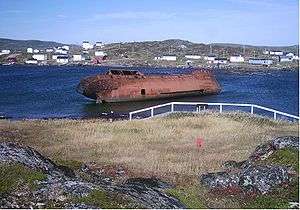Whaling in Canada
Whaling in Canada encompasses both aboriginal and commercial whaling, and has existed on all three Canadian oceans, Atlantic, Pacific, and Arctic. The indigenous peoples of the Pacific Northwest Coast have whaling traditions dating back millennia, and the hunting of cetaceans continues by Inuit (mostly beluga and narwhal, but also the subsistence hunting of the bowhead whale). Commercial whaling was one of the stimuli for Europeans to explore the sub-Arctic and Arctic, possibly as early as the 14th century. By the late 20th century, watching whales was a more profitable enterprise than hunting them.
Pre-contact
Stranded whales, or drift whales that died at sea and washed ashore, provided useful resources such as meat, blubber (rendered into oil) and bone to coastal communities. Eponymous coastal features include Drift Whale Bay within Brooks Peninsula Provincial Park on the Pacific Coast of Vancouver Island.[1][2]
Whaling on the Pacific Northwest Coast goes back millennia, and is deeply intertwined with the culture of the indigenous peoples there.[3] The chiefs built private sacred places, called whalers' washing houses, where they could ritually purify themselves. The best known of these is the Yuquot Whalers Shrine, associated with the great Mowachaht chief Maquinna.[4]
16th century

The Basque whalers reached Newfoundland and Labrador early, possibly a century before Columbus.[5] Certainly they were established by second quarter of the 16th century, when the Basques were hunting in the Strait of Belle Isle, between the island of Newfoundland and the mainland of Labrador. They hunted the North Atlantic right whale and the bowhead whale, although the voyages had begun in search of cod.
17th, 18th, 19th centuries
The Basque "fisheries" ended by 1697.[6]
By this point the British whaling industry was picking up, with ships sent predominantly from Scotland and London. Those that set sail for the Northern whale fishery went either east to the European Arctic (mostly whaling stations on Spitzbergen) or west past Greenland and into what is now the Canadian Arctic. By the 1650s they were whaling in Davis Strait, next to Baffin Island.
The Industrial Revolution massively increased the demand for whale oil, which led to more whaling all over the world. In Arctic Canada it was a significant way for Inuit people to come into contact with the outside world. The Hudson's Bay Company opened trading posts such as Great Whale River in northern Quebec (1820), where products of the commercial whale hunt were processed.
20th century
In the twentieth century there was a commercial whaling industry, small by global standards, in British Columbia, as evidenced by place names such as Blubber Bay. When Coal Harbour closed its whaling station in the late 1960s, the industrial killing of whales in Canada was over. By that point, marine entrepreneurs had moved on to hunting orcas (killer whales) for live capture, to be displayed in aquaria. That lasted about a decade, till public pressure put an end to it in the mid 1970s.
Pour la suite du monde, a classic of Canadian cinema, is a 1963 documentary in which the film producers persuaded the inhabitants of a St Lawrence island to try once again to catch a beluga, something they had not done for decades. The animal is trapped live, and transported by truck to an aquarium in New York City. According to the CBC, "Commercial hunting continued until 1959, and sport hunting lasted another two decades."[7]
Canada withdrew from the International Whaling Commission following the 1986 vote for a moratorium.
21st century
Aboriginal whaling is strong in the Canadian Arctic. Cetaceans are not hunted elsewhere, although humans kill them via ship strike, fishing net entanglement, bio-accumulated pollution, and so on. This means some populations are not only endangered, but not recovering, as for example the talismanic Southern resident killer whales. On the other hand, the modern industry of whale watching is a booming business on Pacific and Atlantic coasts and in the St Lawrence estuary.
See also
- John R. Jewitt, an English blacksmith who spent three years as a captive of the whale-hunting Nuu-chah-nulth people from 1802-1805
- Whaling on the Pacific Northwest Coast
- Whaling in the United States
References
- "#1 – Drift Whale Bay". www.geonames.org. Retrieved 5 May 2018.
- "Drift Whale Bay". knowbc.com. Retrieved 5 May 2018.
- Coté, Charlotte (Charlotte June) (2010). Spirits of our whaling ancestors : revitalizing Makah and Nuu-chah-nulth traditions (1st ed.). Vancouver: UBC Press. p. 20. ISBN 9780295990460. OCLC 551719381.
- Aldona Jonaitis (1999). The Yuquot whalers' shrine. Research contributions by Richard Inglis. Seattle: University of Washington Press. ISBN 9780295978284. OCLC 247081771.
- Barkham, M. M. (1994). "Book review: Proulx, J-P., Basque whaling in Labrador in the 16th century (1993)". Newfound. Stud. 10: 260–286.
- Aguilar, A. 1986. A Review of Old Basque Whaling and its Effect on the Right Whales (Eubalaena glacialis) of the North Atlantic. Reports of the International Whaling Commission (special issue) 10: 191-199.
- "Call of the Baby Beluga". www.cbc.ca. Retrieved 8 January 2019.